|
91 Legacy Sport Sedan Taken from turbo magazine, 9/91. Rock Solid By Thom Cannell(Turbo Magazine 9/91) Words that describe the Subaru: tough, tenacious, dependable. "Exciting" never really entered the picture-then we drove a Legacy Sport Sedan. Subaru's solid, if mundane reputation in the USA is contrary to it's eminence in European Group A and Group N rallying.( They were the winner of Group N in last year's Safari rally and the first ever Group N car-substantially stock- to finish that event.). Also they've built utterly reliable turbocharged engines for years.
Until 1990. when the Legacy Sedan arrived, Subaru owners had no upscale model to move into. It offered front wheel drive with four wheel drive as an option, and is a competitor to Camry and Accord. After only a year they unveiled the Legacy Sport Sedan, a triple whammy variant with 160 horsepower, superior chassis tuning and ABS. Best of all, it retains all the traditional Subaru values-corrosion protective galvanized steel panels, underbody wax, PVC coatings on the floor panel, and wax coatings in nooks, crannies, and inside hidden panels. Experieced car watchers can quickly scope the Legacy Sport Sedan's functional hood scoop routing air to the turbocharger, front air dam and a nicely integrated rear spoiler. but 160 horsepower combined with an outstanding chassis is what gets us stimulated.
Pistons (8.0:1 vs. 9.5:1 in the normally aspirated engine) are moly coated and shot peeded, as are piston pins. Other modifications were made to the first and second ring lands( wider and deeper) for strength and cooling. A tapped in oil spray incorporating a check valve cools pistons' undersides when oil pressure exceeds 57psi. Cooling, always a factor in turbo engines, is accommodated with larger thermostatic fans, a larger radiator , and an overflow tank that is designed to utilize convection flow to absorb ambient heat in the water-cooled turbocharger after engine shut down.
Engine control is extensive. Airflow is metered via a hot-wire sensor, and sequential multi-port fuel injection feed increased capacity injectors. Sensors additionally monitor crankshaft angle, camshaft angle, manifild pressure and exhaust content. Maximum boost is limited to 8.7 psi via signals to the electronic wastegate in the IHI turbocharger. A twin coil distributor-less ignition is used with input from the crank and camshaft sensors. With output a modest 160 horsepower( at 5600 rpm) abnd 181 lbs/ft of torque( at 2800 rpm) there is certainly a wealth of potential available from this engine yet untapped. Subaru is known as the traction company, having offered four wheel drive in passenger cars since 1975. For the Sport Sedan, no less then two distictly different systems are offered, based on transmission choice. Five-speed drivers receive a "conventional" mechanical center differential and viscous limitied slip for both rear and front differential. The five speed has been modified to handle extra power-all the internal gears are shot peened, and all the main shaft bearings are changed to double-angular bearings. Also the transmission case is changed to accept a hydraulic clutch. Flywheel, pressure plate, clutch disk, even the pedal mounting plate have all been strengthened.
The Legacy Sport Sedan electronic transmission is uprated to handle increased torque. Changes include a larger microprocessor-controlled lock-up torque converter which controls lock-up in second, third, and fourth gear; data input includes throttle position and vehicle speed. Additionally the input shaft is shot peened and more plates are intorduced in the clutch assemble. The micro-controller handles other tasks as well, holding fourth gear at low speed when cruise control is engaged for improved fuel economy and preventing fourth gear from being engaged on a cold transmission. It will also vary shift points in a hot transmission. The most interesting point of the microcontroller is its "power" and "normal" modes with manual override. "Normal" characteristics are pursuant to a series of decision tables stored in the computer. These provide reference points to determine shift patterns for different speeds and throttle positions. Pressing the pedal quickly automatcially puts the tranny in "power" mode (we found you really had to mash the throttle for it to get the idea) while the override holds a sleceted gear. The sport Sedan is inteded for world wide distribution, its suspension system factory tuned to a variety of environments from European firmess to settings best suited to smooth american highways. Its suspension is an outstanding feature, one you should experience. At the rear, McPhearson type coil-over struts are located by a trailing arm and two parallel links with a stabilizer bar. Up front McPherson struts with coil springs are located by L-shaped control arms using silicone filled pivot bushings. A front stabilizer bar is fitted, as well. the suspension is progressive and at the limit apporximately 70 percent stiffer than a standard issue Legacy.
Steering is firm and tight, and engine-speed-based variable power-assist rack and pinion system. With a 33'6" turning circle and 3.3 turns lock-to-lock, steering input is well suited to brisk driving. Brakes are 10.9 inch diameter ventilated discs in front and 10.5 inch diameter vented discs in the rear, all with dual piston caliper. As mentioned, Bosch four channel ABS is standard; this puppy stops very well indeed.
Our conclusion is that the chassis is firm without harshness, the springs, bushings, and shocks all spot on. Steering input reponsiveness, turn in response, transient maneuver reponse are all the top of the class, enhanced , no doubt by a 57/43 percent weight distribution. We even did a bit of back woods driving to add to the mix. There we thought somewhat softer rates might be nice, but it could have been the tires, 195/60HRx15 all weather Bridgstone RE-92 tires mounted on 15x6J alloy wheels. Inside, the Legacy sport Sedan features adjustable seats, center console bins, coin trays, drink holder, and map pockets. The instrument panel houses analog guages and leather wraps the steering wheel, shift knob, and hand brake. all the scondary displays and instuments are easy to read, easy to use. the standard AM/FM cassette blsows 80 watts through four speakers and an equalizer. It features an auxilary jack so you can plug in your portable CD player. Subaru expects the Sport Sedan to achieve three to five percent of total Legacy sales. With the $19,224 list price, they should reach that goal.
Naturally, with so robust and engine, we'd increase the horspower. So we're planning a project car, one with significantly more horsepower, an interior that better reflects the luxo-touring nature of this automobile, superior wheels and tires, and of course a killer sound system. We may evbe go for a custom paint job to add the penultimate touch. * |

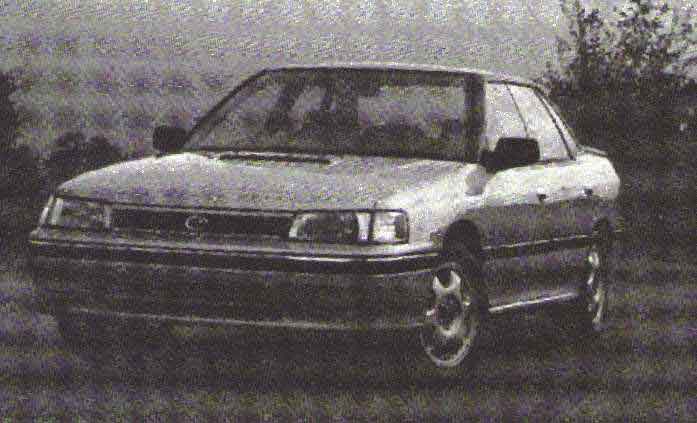
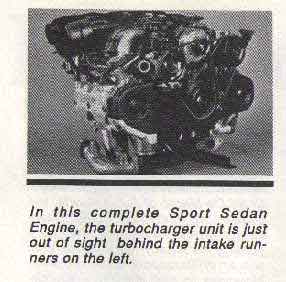 Nestled
beneath the hood is what appears to be a familiar Subaru Boxer engine.
It looks like the standard SOHC, 16 valve aluminum engine with cast-iron
cylinder liners, it even displaces the same 2,212 cubic centimeters( 134.98
cu. in.). Appearance is deceptive as this is a purpose-built engine beginning
with the crank, where narrow journal spacing creates a compact and rigid(
bullet-proof) bottom end. Main bearings are modified for better lube retention
and load bearing.
Nestled
beneath the hood is what appears to be a familiar Subaru Boxer engine.
It looks like the standard SOHC, 16 valve aluminum engine with cast-iron
cylinder liners, it even displaces the same 2,212 cubic centimeters( 134.98
cu. in.). Appearance is deceptive as this is a purpose-built engine beginning
with the crank, where narrow journal spacing creates a compact and rigid(
bullet-proof) bottom end. Main bearings are modified for better lube retention
and load bearing.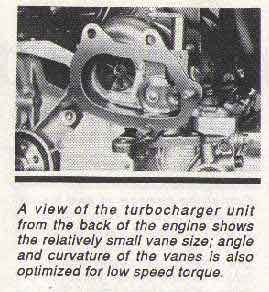 The
heads are significantly different. Coolant passages were redesigned and
valve seats hardened. A unique rocker assembly operates the valves: each
intake has its own rocker, while a forked rocker arm opens two exhaust
valves simultaneously. Hydraulic valve adjusters are used. Camshafts are
driven by a toothed, reinforced rubber belt.
The
heads are significantly different. Coolant passages were redesigned and
valve seats hardened. A unique rocker assembly operates the valves: each
intake has its own rocker, while a forked rocker arm opens two exhaust
valves simultaneously. Hydraulic valve adjusters are used. Camshafts are
driven by a toothed, reinforced rubber belt.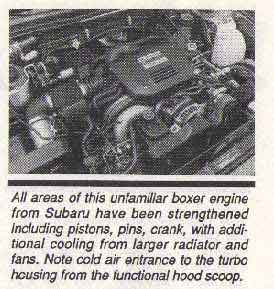 An
optional electronic four-speed transmission is available- and Subaru expects
60-70 percent of sales to be so equipped. This four wheel drive system
uses a computer controlled multi-plate clutch to distribute power between
the front and rear wheels. ( Porsche and Mercendes use similar systems.)
The 4EAT, like the manual, features a viscous coupled limited slip rear
differential. (In case you're unfamiliar with these, in operation, speed
differences between same-axle wheels cause clutch plates to shear through
a silicon fluid. It heats, expands and increases pressure between the
clutch plates, thus transferring power.)
An
optional electronic four-speed transmission is available- and Subaru expects
60-70 percent of sales to be so equipped. This four wheel drive system
uses a computer controlled multi-plate clutch to distribute power between
the front and rear wheels. ( Porsche and Mercendes use similar systems.)
The 4EAT, like the manual, features a viscous coupled limited slip rear
differential. (In case you're unfamiliar with these, in operation, speed
differences between same-axle wheels cause clutch plates to shear through
a silicon fluid. It heats, expands and increases pressure between the
clutch plates, thus transferring power.) 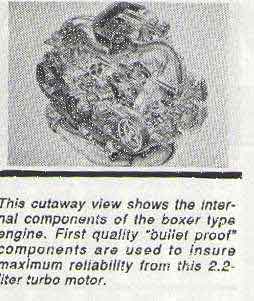 Unlike
the manual transimssion four wheel drive system, the automatic uses a
hydraulic multi-plate center differential with rear wheel speed sensors
and computer control.By comparing front-to-rear wheel speed the controller
"knows" when the car is cornering or slipping( the Legacy Sport Sedan
has full four channel Bosch ABS). Information about gear, engine speed,
and throttle position are factored in, and based on these, the microcontroller
actively changes power flow. To do this it activates a "chatter" solenoid
which constanly adjusts pressure in the multi-plate clutch. Modulation
is from primarily front wheel drive to a maximum of 50 percent front-to-rear
torque distribution.
Unlike
the manual transimssion four wheel drive system, the automatic uses a
hydraulic multi-plate center differential with rear wheel speed sensors
and computer control.By comparing front-to-rear wheel speed the controller
"knows" when the car is cornering or slipping( the Legacy Sport Sedan
has full four channel Bosch ABS). Information about gear, engine speed,
and throttle position are factored in, and based on these, the microcontroller
actively changes power flow. To do this it activates a "chatter" solenoid
which constanly adjusts pressure in the multi-plate clutch. Modulation
is from primarily front wheel drive to a maximum of 50 percent front-to-rear
torque distribution. 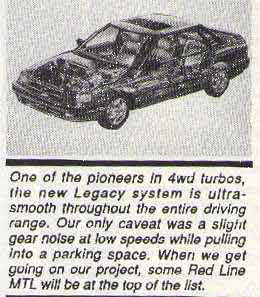 Enough
of the techno-wonders, what's it like to drive. Shocking! This is a delightful,
fun-to-drive-hard car. And the harder you drive, the more fun it generates.
With zero-60 times of 7.9 seconds(manual), quarter miles in 16.1 seconds,
and top speed a tad under 130mph, its a competent performer. We found
this out by getting lost (quite unintentionally) while on the introduction
trip. Rejoining the group was scofflaw brisk- the car remaining stable
and predictable at all times. At one point we tested the suspension severely
on a blind corner. Once around it, the road heaved upabruptly over a railroad
track that immediately dropped away sharply left. "No problem, dude!"-
was the chassis message- this car jumps well.
Enough
of the techno-wonders, what's it like to drive. Shocking! This is a delightful,
fun-to-drive-hard car. And the harder you drive, the more fun it generates.
With zero-60 times of 7.9 seconds(manual), quarter miles in 16.1 seconds,
and top speed a tad under 130mph, its a competent performer. We found
this out by getting lost (quite unintentionally) while on the introduction
trip. Rejoining the group was scofflaw brisk- the car remaining stable
and predictable at all times. At one point we tested the suspension severely
on a blind corner. Once around it, the road heaved upabruptly over a railroad
track that immediately dropped away sharply left. "No problem, dude!"-
was the chassis message- this car jumps well. 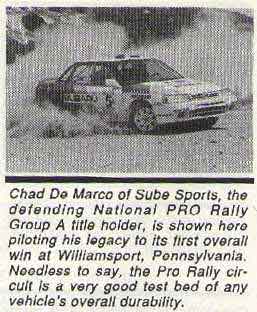 If
we sound impressed, we are. But we have a few ideas of how to improve
this product. At least it should recieve a better interior, one measuring
up to the Legacy LSi to compete effectively in the market segment. Next
on our list would be distinctive wheels and more adhesive tires for
the same reason.
If
we sound impressed, we are. But we have a few ideas of how to improve
this product. At least it should recieve a better interior, one measuring
up to the Legacy LSi to compete effectively in the market segment. Next
on our list would be distinctive wheels and more adhesive tires for
the same reason.